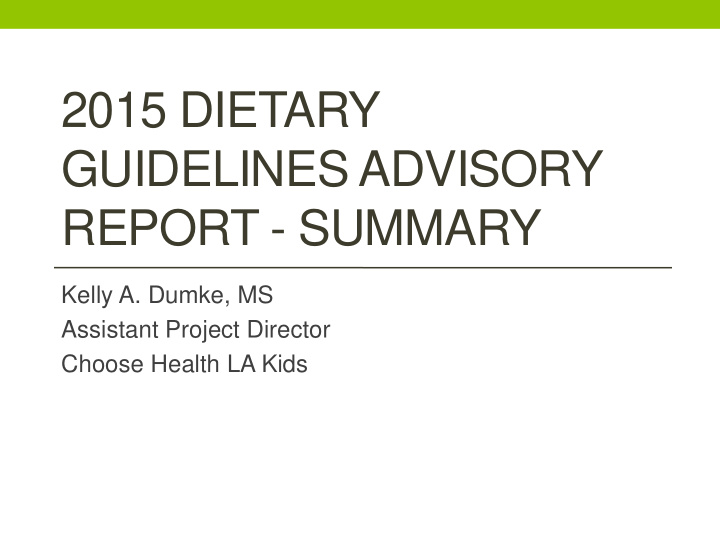



2015 DIETARY GUIDELINES ADVISORY REPORT - SUMMARY Kelly A. Dumke, MS Assistant Project Director Choose Health LA Kids
What is it? Why is it important? Guidance Foundation • Guidance for making • Foundation for all food and physical Federal nutrition activity choices that policy, education, promote good health, outreach, and food healthy weight, and assistance programs help prevent disease used by consumers, for Americans ages 2 industry, nutrition and over educators, and health professionals
What programs are impacted? • Centers for Disease Control and Prevention • Food and Nutrition Service • Food and Drug Administration • WIC • National Institutes of Health • SNAP • Office of Disease Prevention and Health • School Breakfast Promotion • School Lunch • Other • Child and Adult Care Food Program • Food Safety and Inspection Services • Center for Nutrition Policy and Promotion • Economic Research Service • Agricultural Research service • Other Health and U.S. Human Department of Services Agriculture
Why does it only address Americans ages 2 and older? Beginning in 2020, the Dietary guidelines will address Americans of all ages starting at birth.
Dietary Guidelines Process • 2015 Dietary Guidelines Advisory Committee • Establish by U.S. Department of Health and Human Services and U.S. Department of Agriculture • Charge : Examine new evidence with primary emphasis on development of food-based recommendations. • New: • Focus on sustainability • Focus on foods and less nutrient-specific
2015 Dietary Guidelines Advisory Report was guided by two realities… Prevalence of preventable, chronic Social-ecological Influencers conditions and disease • Personal • Social • ½ all U.S. adults (117 million individual) have one or more • Organizational preventable, chronic diseases • 2/3 of all U.S. adults (115 million individuals) are overweight • Environmental or obese • Systems • Direct Contributors: • Poor dietary patterns • Overconsumption of calories • Physical inactivity
Report Organization Food & Nutrient Intakes Dietary Patterns & Health Outcomes Individual Lifestyle & Behavior Change Food Environment and Settings Food Sustainability and Safety Cross-cutting Topics of Public Health Importance Physical Activity
Chapter 1 Food & Nutrient Intakes
Food & Nutrient Intakes Nutrient Perspective Nutrient Perspective Shortfall Nutrients Overconsumed Nutrients Vitamin A Sodium Vitamin D Saturated Fat Vitamin E Vitamin C Folate Calcium Magnesium Fiber Potassium Iron (adolescents and premenopausal females only)
Food & Nutrient Intakes Food Perspective Food Group Perspective Food Category Perspective (Composition Change) Too Low Too High Increase Decrease Vegetables Refined Food groups : Food group : Fruits Grains Vegetables Refined Grains Whole Grains Added Sugars Fruits Added Sugars Dairy Whole Grains Nutrients : Sodium Saturated Fat
Chapter 2 Dietary Patterns & Health Outcomes
Dietary Patterns & Health Outcomes Overall dietary p atterns should be… Higher in… Moderate in… Lower in… • Fruits • Alcohol • Red and • Vegetables • Non/low-fat processed meats dairy • Whole grains • Refined • Seafood grains • Legumes • Sugar- • Nuts sweetened foods and beverages
Chapter 3 Individual Lifestyle & Behavior Change
Individual Diet & Physical Activity Behavior Change Access to healthy foods Affordability Immigrant of health status foods Individual Level Behavior Change Household Incorporate food cultural preferences insecurity Food Labels & Literacy
Individual Diet and Physical Activity Behavior Change Food Insecurity • Stronger Federal policies to help prevent and/or cope with food insecurity Prevention • Food and nutrition assistance programs to take into account Immigrant/Minority the risk that immigrants have of giving up healthier dietary Considerations habits. • Efforts to provide all individuals living in the U.S. with the Social-ecological environments, knowledge, and tools needed to implement Change effective individual- or family-level behavior change strategies to improve diet and reduce sedentary behaviors.
Chapter 4 Food Environment and Settings
Food Environment and Settings • Examined Four Settings: • Community Food Access • Child Care • Schools • Worksites • Found : Multi-component Interventions Key • For Obesity Prevention • Environmental policies to address availability of healthy foods and beverages • Increased parent engagement • Education approaches • For Dietary Interventions • Nutrition education • Parent engagement • Environmental modifications
Chapter 5 Food Sustainability and Safety
Food Sustainability Diets higher in plant-based foods, such as vegetables, fruits, whole grains, legumes, nuts, and seeds and lower in calories and animal-based foods is associated with less environmental impact than the current U.S. diet.
Food Safety Coffee High Caffeine Drinks Sugar Substitutes
Chapter 6 Cross-cutting Topics of Public Health Importance
Cross-cutting Topics of Public Health Importance • Goals for general population: • Less than 2,300 mg dietary sodium/day (or age-appropriate Dietary Reference Intake) • Less than 10% calories from saturated fat per day • Less than 10% calories from added sugars per day • Emphasis on healthy dietary patterns over isolated reductions • Policies and programs • Local, state, national • Private and public sectors
Chapter 7 Physical Activity
Physical Activity • Physical Activity Guidelines for Americans 2008 (review in 2013) • Physical activity throughout the lifecycle
Integrating the Evidence Individuals Culture Government Families of Health Industry Communities
Implications for ECOPI Call for multi-component obesity prevention effort Emphasis on all levels of the socio ecologic model Focus on policy Encourage public & private sector approaches Inform early childhood evidence base
Next Steps
More Information • Visit: http://health.gov/dietaryguidelines/2015.asp • Public Comment Hearing: March 24, 2015
Recommend
More recommend